Occupancy-Based Energy Consumption Estimation Improvement through Deep Learning
Abstract
1. Introduction
1.1. Background of Research
1.2. Related Work
1.3. Proposed Method
2. Methodology
2.1. Data Collection
2.1.1. Data Collection for Occupancy
2.1.2. Data Collection for Energy Consumption
2.1.3. Data Preprocessing
2.2. Methodology for Estimating Occupancy
2.2.1. Data Analysis for Estimating Occupancy
2.2.2. Estimating the Occupancy Based on Deep Learning
2.3. Methodology for Estimating Energy Consumption
2.3.1. Data Analysis for Estimating Energy Consumption
2.3.2. Estimating Energy Consumption Based on Deep Learning
3. Experiments and Results
3.1. Experimental Environment
3.2. Estimation of Occupancy
3.2.1. Data Analysis
3.2.2. Estimation of Occupancy Using Deep Learning
3.3. Prediction of Energy Consumption
3.3.1. Analysis of Energy Consumption
3.3.2. Analysis of the Correlation between Occupancy and Energy Consumption
3.3.3. Prediction of Energy Consumption Using Deep Learning
4. Conclusions
Author Contributions
Funding
Institutional Review Board Statement
Informed Consent Statement
Data Availability Statement
Acknowledgments
Conflicts of Interest
References
- The Critical Role of Buildings. Available online: https://www.iea.org/reports/the-critical-role-of-buildings (accessed on 29 December 2022).
- Yoshino, H.; Hong, T.; Nord, N. IEA EBC annex 53: Total energy use in buildings—Analysis and evaluation methods. Energy Build. 2017, 152, 124–136. [Google Scholar] [CrossRef]
- Zhang, Y.; Bai, X.; Mills, F.P.; Pezzey, J.C.V. Rethinking the role of occupant behavior in building energy performance: A review. Energy Build. 2018, 172, 279–294. [Google Scholar] [CrossRef]
- Salimi, S.; Hammad, A. Critical review and research roadmap of office building energy management based on occupancy monitoring. Energy Build. 2019, 182, 214–241. [Google Scholar] [CrossRef]
- Sun, K.; Zhao, Q.; Zou, J. A review of building occupancy measurement systems. Energy Build. 2020, 216, 109965. [Google Scholar] [CrossRef]
- Chen, Z.; Jiang, C.; Xie, L. Building occupancy estimation and detection: A review. Energy Build. 2018, 169, 260–270. [Google Scholar] [CrossRef]
- Raykov, Y.P.; Ozer, E.; Dasika, G.; Boukouvalas, A. Predicting room occupancy with a single passive infrared (PIR) sensor through behavior extraction. In Proceedings of the UbiComp ‘16: Proceedings of the 2016 ACM International Joint Conference on Pervasive and Ubiquitous Computing, Heidelberg, Germany, 12–16 September 2016; pp. 1016–1027. [Google Scholar]
- Lee, S.S.; Kim, M.B. Convolutional Neural Network–Based Human Recognition for Vision Occupancy Sensors. In Proceedings of the International Conference on Image Processing, Computer Vision, and Pattern Recognition (IPCV). The Steering Committee of The World Congress in Computer Science, Computer Engineering and Applied Computing (WorldComp), Las Vegas, NA, USA, 30 July–2 August 2018; pp. 10–15. [Google Scholar]
- Zuraimi, M.S.; Pantazaras, A.; Chaturvedi, K.A.; Yang, J.J.; Tham, K.W.; Lee, S.E. Predicting occupancy counts using physical and statistical Co2-based modeling methodologies. Build. Environ. 2017, 123, 517–528. [Google Scholar] [CrossRef]
- Ouf, M.M.; Issa, M.H.; Azzouz, A.; Sadick, A.M. Effectiveness of using WiFi technologies to detect and predict building occupancy. Sustain. Build. 2017, 2, 7. [Google Scholar] [CrossRef]
- Alishahi, N.; Ouf, M.M.; Nik-Bakht, M. Using WiFi connection counts and camera-based occupancy counts to estimate and predict building occupancy. Energy Build. 2022, 257, 111759. [Google Scholar] [CrossRef]
- Wang, F.; Feng, Q.; Chen, Z.; Zaho, Q.; Cheng, Z.; Zou, J.; Zhang, Y.; Mai, J.; Li, Y.; Reeve, H. Predictive control of indoor environment using occupant number detected by video data and CO2 concentration. Energy Build. 2017, 145, 155–162. [Google Scholar] [CrossRef]
- Ravi, A.; Misra, A. Robust, Fine-Grained Occupancy Estimation via Combined Camera & WiFi Indoor Localization. In Proceedings of the 2020 IEEE 17th International Conference on Mobile Ad Hoc and Sensor Systems (MASS), Delhi, India, 10–13 December 2020; pp. 558–566. [Google Scholar]
- Wang, W.; Hong, T.; Xu, N.; Chen, J.; Shan, X. Cross-source sensing data fusion for building occupancy prediction with adaptive lasso feature filtering. Build. Environ. 2019, 162, 106280. [Google Scholar] [CrossRef]
- Simma, K.C.J.; Mammoli, A.; Bogus, S.M. Real-Time Occupancy Estimation Using WiFi Network to Optimize HVAC Operation. Procedia Comput. Sci. 2019, 155, 495–502. [Google Scholar] [CrossRef]
- Salimi, S.; Hammad, A. Optimizing energy consumption and occupants comfort in open-plan offices using local control based on occupancy dynamic data. Build. Environ. 2020, 176, 106818. [Google Scholar] [CrossRef]
- Shi, J.; Yu, N.; Yao, W. Energy Efficient Building HVAC Control Algorithm with Real-time Occupancy Prediction. Energy Procedia 2017, 111, 267–276. [Google Scholar] [CrossRef]
- Tekler, Z.D.; Low, R.; Yuen, C.; Blessing, L. Plug-Mate: An IoT-based occupancy-driven plug load management system in smart buildings. Build. Environ. 2022, 223, 109472. [Google Scholar] [CrossRef]
- Ding, Y.; Wang, Q.; Wang, Z.; Han, S.; Zhu, N. An occupancy-based model for building electricity consumption prediction: A case study of three campus buildings in Tianjin. Energy Build. 2019, 202, 109412. [Google Scholar] [CrossRef]
- Wei, Y.; Xia, L.; Pan, S. Prediction of occupancy level and energy consumption in office building using blind system identification and neural networks. Appl. Energy 2019, 240, 276–294. [Google Scholar] [CrossRef]
- Markovic, R.; Azar, E.; Annaqeeb, M.K.; Frisch, J.; Treeck, C.V. Day-ahead prediction of plug-in loads using a long short-term memory neural network. Energy Build. 2021, 234, 110667. [Google Scholar] [CrossRef]
- Anand, P.; Deb, C.; Yan, K.; Yang, J.; Cheong, D.; Sekhar, C. Occupancy-based energy consumption modelling using machine learning algorithms for institutional buildings. Energy Build. 2021, 252, 111478. [Google Scholar] [CrossRef]
- Wang, Z.; Hong, T.; Piette, M.A. Predicting plug loads with occupant count data through a deep learning approach. Energy 2019, 181, 29–42. [Google Scholar] [CrossRef]
- Anand, P.; Cheong, D.; Sekhar, C.; Santamouris, M.; Kondepudi, S. Energy saving estimation for plug and lighting load using occupancy analysis. Renew. Energy 2019, 143, 1143–1161. [Google Scholar] [CrossRef]
- LeCun, Y.; Bengio, Y.; Hinton, G. Deep learning. Nature 2015, 521, 436–444. [Google Scholar] [CrossRef] [PubMed]
- Nwankpa, C.; Lijomah, W.; Gachagan, A.; Marshall, S. Activation Functions: Comparison of trends in Practice and Research for Deep Learning. arXiv 2018, arXiv:1811.03378. [Google Scholar]
- Luo, X.J.; Oyedele, L.O.; Ajayi, A.O.; Akinade, O.O.; Owolabi, H.A.; Ahmed, A. Feature extraction and genetic algorithm enhanced adaptive deep neural network for energy consumption prediction in buildings. Renew. Sustain. Energy Rev. 2020, 131, 109980. [Google Scholar] [CrossRef]
- Hahnloser, R.H.R.; Sarpeshkar, R.; Mahowald, M.A.; Douglas, R.J.; Seung, H.S. Digital selection and analogue amplification coexist in a cortex-inspired silicon circuit. Nature 2000, 405, 947–951. [Google Scholar] [CrossRef] [PubMed]
- Kim, M.L.; Son, S.Y. Study on the relationship between resident number and energy consumption using AI human body detection technology. In Proceedings of the Symposium of the Korean Institute of communications and Information Sciences, Gangwondo, Republic of Korea, 9–11 February 2022; pp. 1008–1009. [Google Scholar]
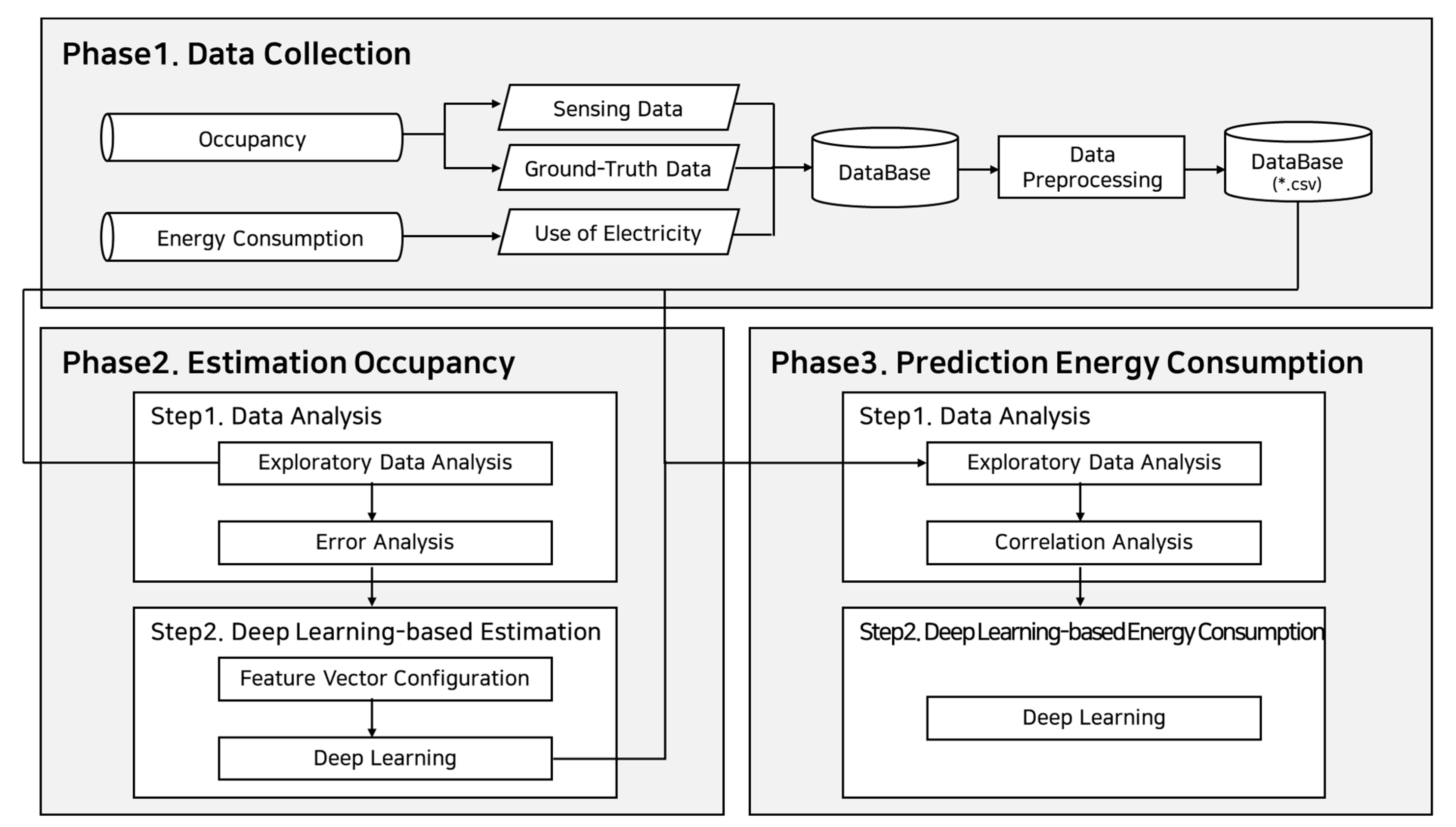









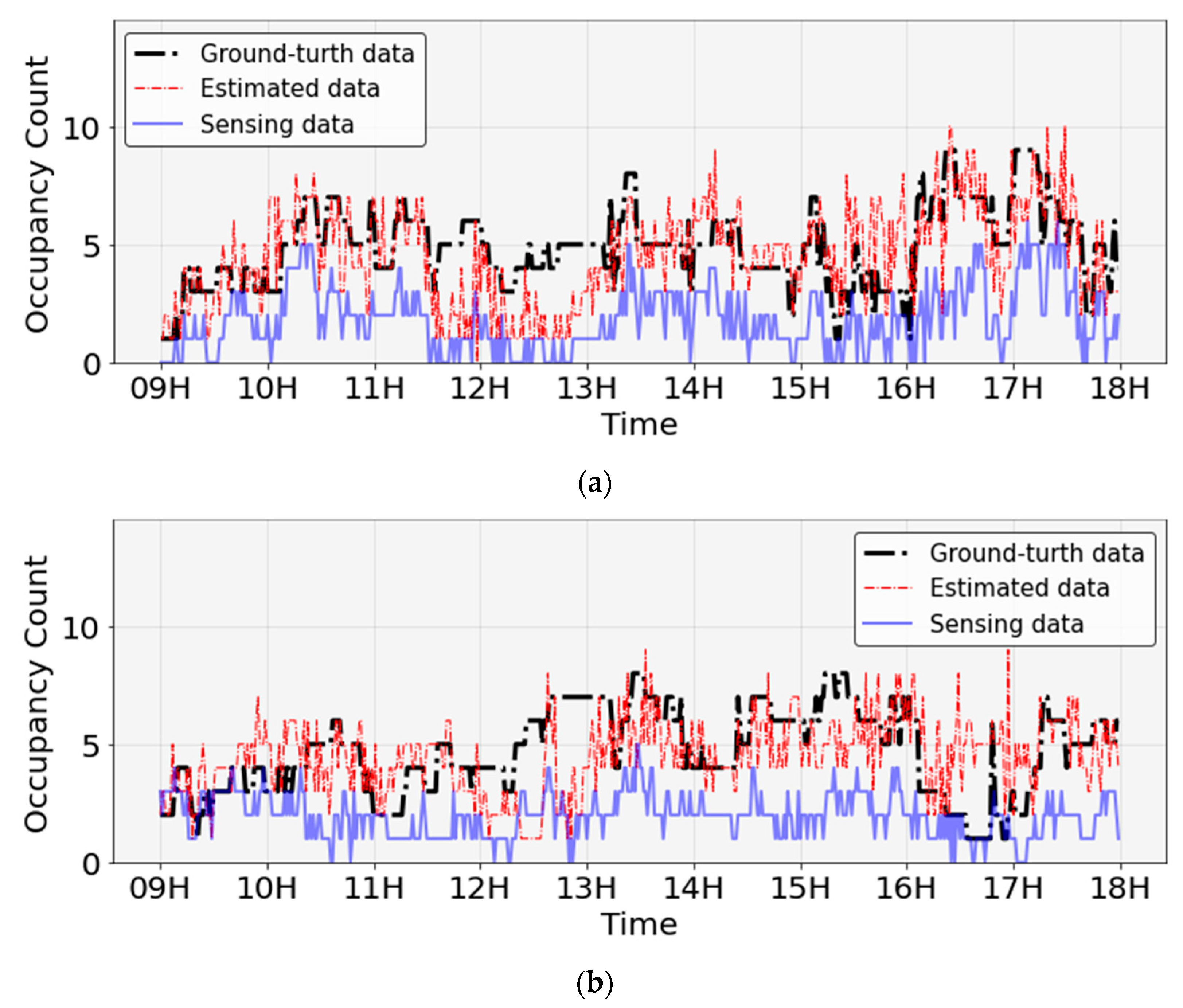

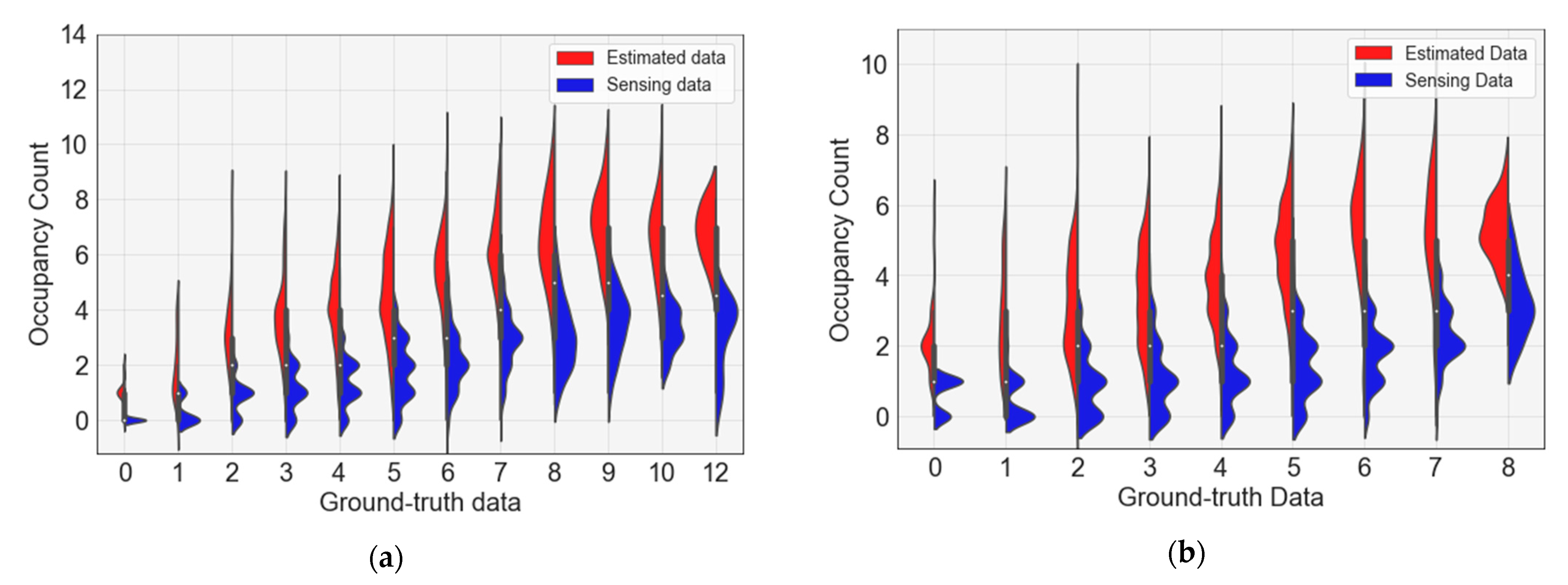
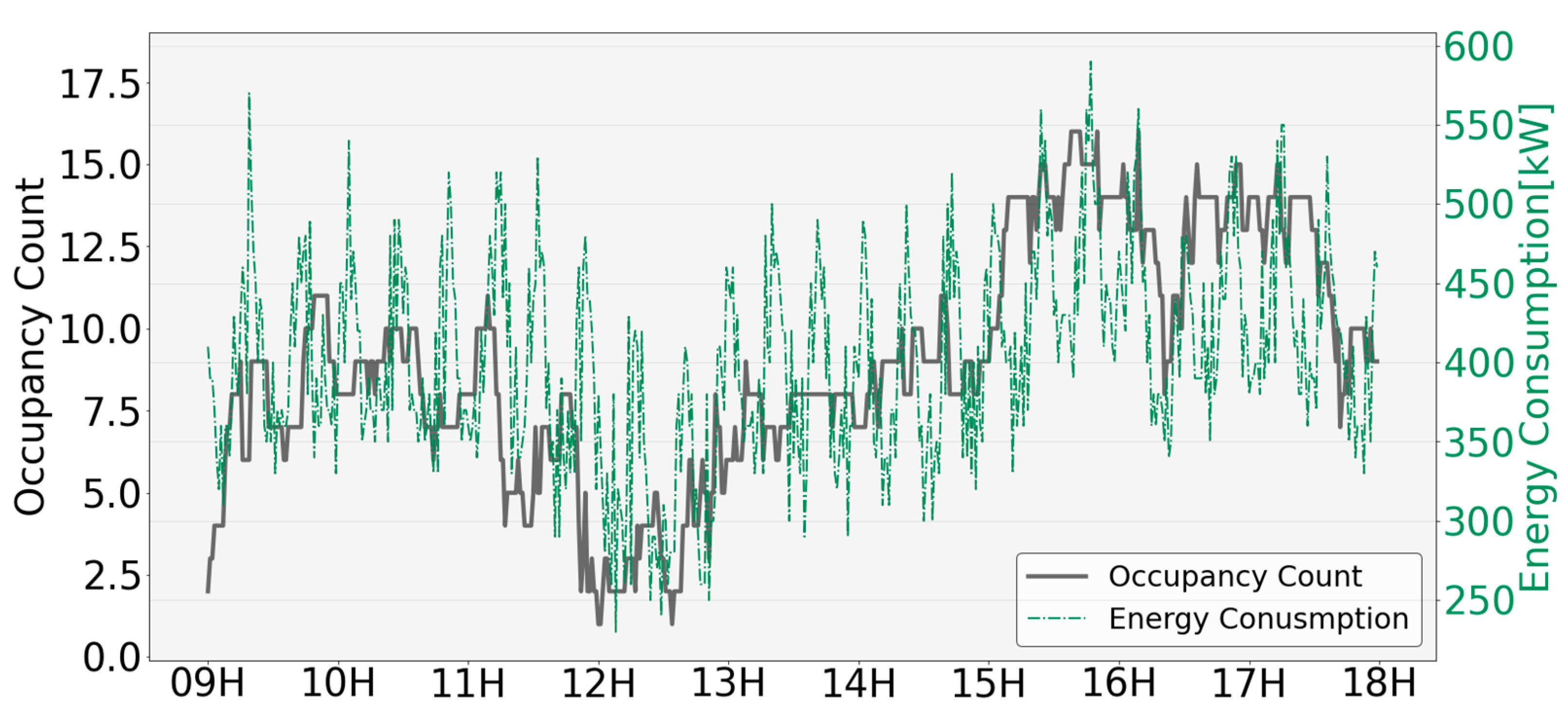
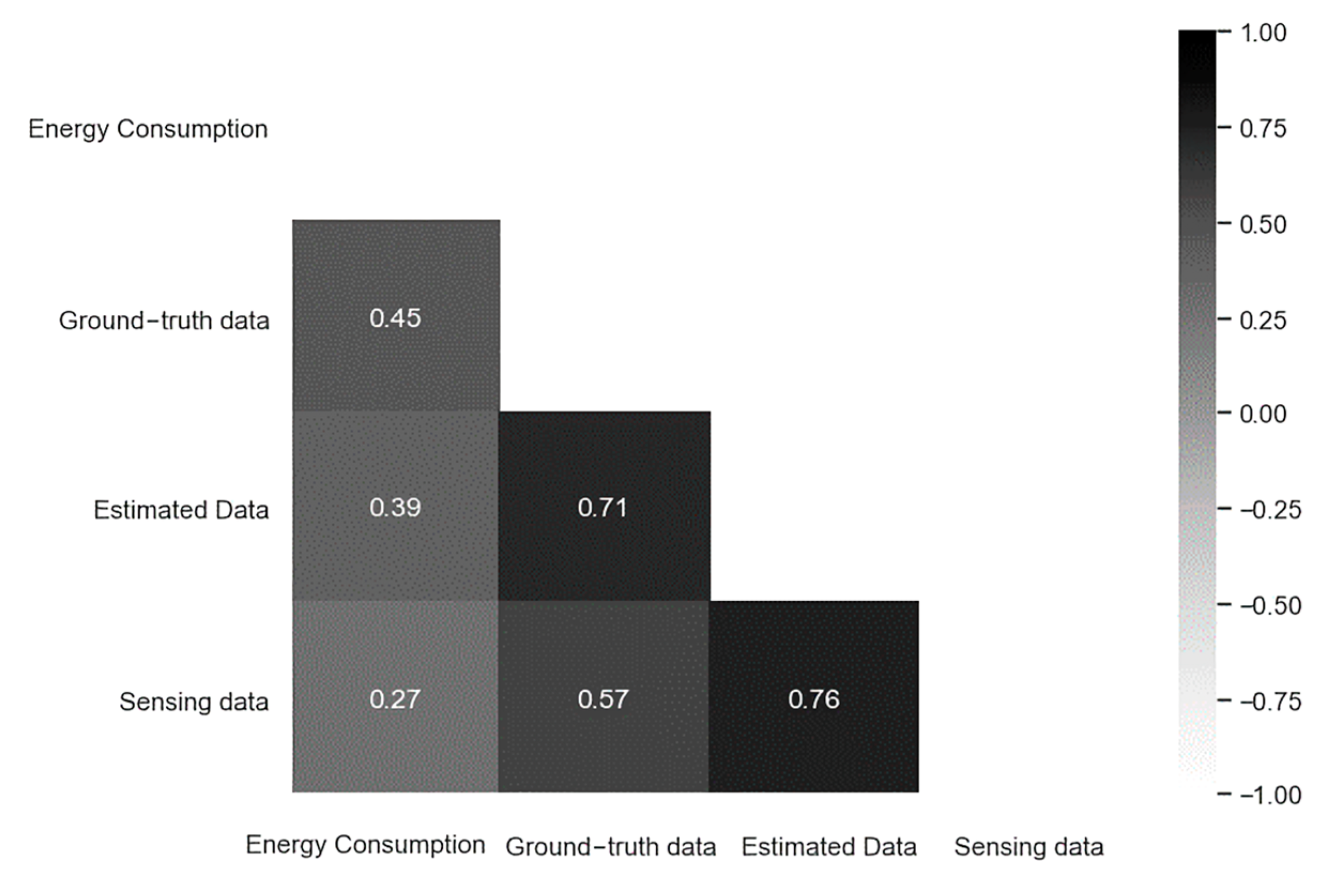


| Reference | Case | Load | Occupancy Sensor | Method | Electricity Consumption | Performance |
|---|---|---|---|---|---|---|
| Ding et al. [19] | Campus Building | HVAC, Plug, Light | PIR | Mathematical | 680 W (average) | Within 5% |
| Wei et al. [20] | Commercial Building | HVAC | CO2 | Ensemble | ~940 W (average) | RMSE 30 |
| Markovic et al. [21] | Campus Buildings | Plug | PIR | LSTM | 365 W (peak) | RMSE 19 |
| 900 W (peak) | RMSE 54 | |||||
| 367 W (peak) | RMSE 82 | |||||
| Anand et al. [22] | Institutional Building | Plug, Light | WiFi | ANN-DN | ~500 kW (peak) | RMSE 32.5 |
| Wang et al. [23] | Office Building | Plug | Camera | LSTM | ~15 kW (peak) | RMSE 0.42 |
| MAE | MSE | RMSE | ||||
|---|---|---|---|---|---|---|
| Room 1 | Room 2 | Room 1 | Room 2 | Room 1 | Room 2 | |
| Estimation (Proposed) | 1.4 | 1.5 | 3.5 | 3.6 | 1.9 | 1.9 |
| Sensing (Conventional) | 3.1 | 2.6 | 12.3 | 9.1 | 3.5 | 3.0 |
| MAE | MSE | RMSE | CV(RMSE) | MAPE | |
|---|---|---|---|---|---|
| Ground-truth | 4.4 | 29.6 | 5.4 | 13.0% | 0.107 |
| Estimation (Proposed) | 4.5 | 31.3 | 5.6 | 13.4% | 0.107 |
| Sensing (Conventional) | 4.7 | 34.7 | 5.9 | 14.1% | 0.111 |
Disclaimer/Publisher’s Note: The statements, opinions and data contained in all publications are solely those of the individual author(s) and contributor(s) and not of MDPI and/or the editor(s). MDPI and/or the editor(s) disclaim responsibility for any injury to people or property resulting from any ideas, methods, instructions or products referred to in the content. |
© 2023 by the authors. Licensee MDPI, Basel, Switzerland. This article is an open access article distributed under the terms and conditions of the Creative Commons Attribution (CC BY) license (https://creativecommons.org/licenses/by/4.0/).
Share and Cite
Kim, M.-L.; Park, K.-J.; Son, S.-Y. Occupancy-Based Energy Consumption Estimation Improvement through Deep Learning. Sensors 2023, 23, 2127. https://doi.org/10.3390/s23042127
Kim M-L, Park K-J, Son S-Y. Occupancy-Based Energy Consumption Estimation Improvement through Deep Learning. Sensors. 2023; 23(4):2127. https://doi.org/10.3390/s23042127
Chicago/Turabian StyleKim, Mi-Lim, Keon-Jun Park, and Sung-Yong Son. 2023. "Occupancy-Based Energy Consumption Estimation Improvement through Deep Learning" Sensors 23, no. 4: 2127. https://doi.org/10.3390/s23042127
APA StyleKim, M.-L., Park, K.-J., & Son, S.-Y. (2023). Occupancy-Based Energy Consumption Estimation Improvement through Deep Learning. Sensors, 23(4), 2127. https://doi.org/10.3390/s23042127






